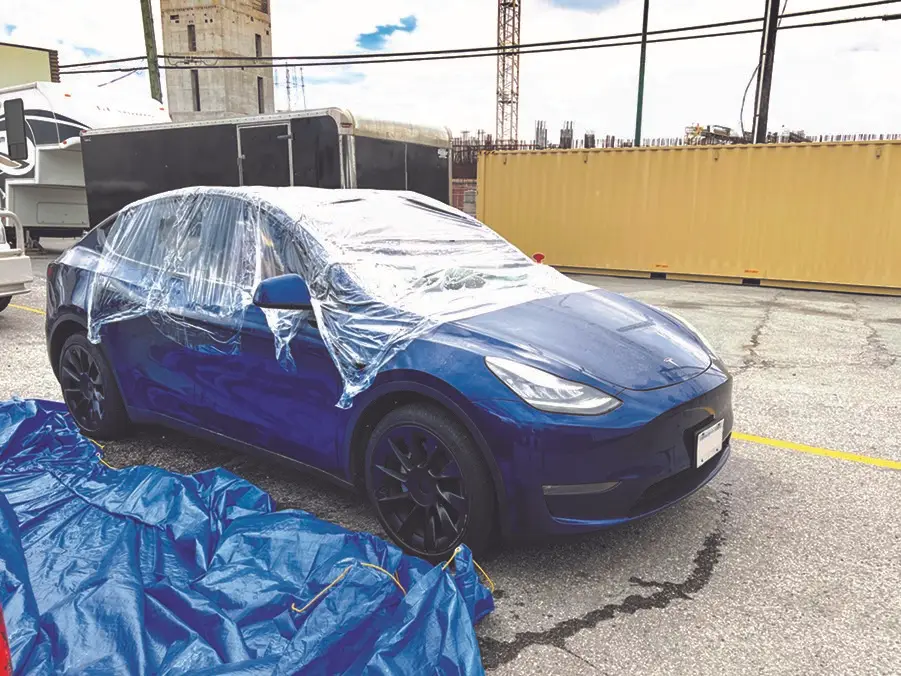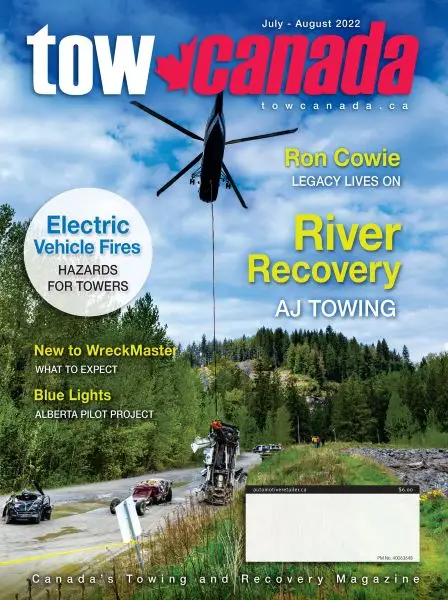A blazing Tesla raises questions about towing, storage, safety, training, and more.
by Kara Cunningham
On Friday, May 20, in North Vancouver, Jamil Jutha was driving his 2021 Tesla Model Y when he received an error message just before his vehicle lost power. The vehicle shut down, smoke filled the cabin, and Jutha struggled to exit given both the door and windows were now inoperable:
“I had to smash the window,” said Jutha. “I kicked through the window because everything stopped. The power didn’t work. The door didn’t open. The windows didn’t go down.”1
Following Jutha’s escape2, the vehicle burst into flames, and the North Vancouver City Fire Department arrived minutes later to extinguish the fire. Luckily, nobody was injured, and Mitchell’s Towing Ltd. was called to remove the casualty.
Now there is an old saying: “If you think education is expensive, try ignorance.” While it is important to remember that electric vehicles (EVs) are not known to catch on fire at a higher rate than gasoline-powered vehicles,3 there are special hazards associated with the towing and storage of a damaged EV.
As noted by the Automotive Retailers Association (ARA), which offers training on the safe handling of EVs: “In addition to the hazards posed by damaged high-voltage batteries, EVs pose other risks that, if not properly handled, can result in serious injury or death. These can include electric shock, fire, chemical burns, or even being pinned or struck by a vehicle that has not been properly disabled.”4
Background
EVs have been around for a while now, and the writing is on the wall. With fuel prices soaring and a federal mandate requiring all new passenger vehicles sold to be 100% electric by 2035, the future of EVs in Canada has never seemed more secure, and the market is growing fast.5
According to a poll by Clean Energy Canada and Abacus Data, “Roughly 80% of Canadians are open to buying an EV for their next vehicle,” and according to a recent poll by KPMG, “51% of Canadians say they will never buy a gas-powered vehicle again, while 61% say rising gas prices and oil supply challenges have convinced them it’s time to buy an EV.”6 There are also 68 electric vehicle models currently available in Canada, with an estimated 130 models coming to market by 2023.7
Sooner or later all these EVs are going to need attention. According to the Ministry of Energy, Mines and Low Carbon Innovation, “The number of electric vehicles on B.C. roads alone has increased by 1,600% in the past six years as a result of the Province’s CleanBC Go Electric programs.”8 Qualified industry professionals are increasingly needed to sell, service, repair, tow, and recycle zero-emission electric vehicles in a responsible and safe manner.
"Roughly 80% of Canadians are open to buying an EV for their next vehicle.”
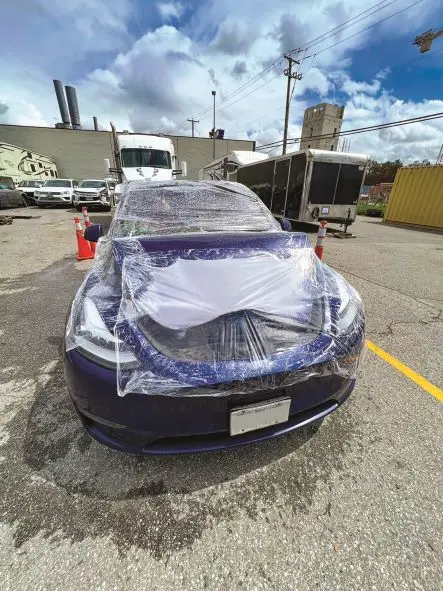
The call
It was Mitchell’s Towing that received the call that day to attend Jutha’s Tesla, a company that has had a great deal of experience with EVs. Given its location in North Vancouver, Mitchell’s Towing is in the epicentre of EV wonderland: “British Columbia receives more EVs per capita than any other Canadian province, and has the highest sales rate in North America,” according to BC Hydro.9
British Columbia is also the first place in the world to have a 100% zero-emission vehicles law (2019).10 In its 2022 budget, the B.C. government has also introduced a provincial sales tax exemption for used EVs, effective until 2027, increasing the affordability of the vehicles.
Given its clientele, Mitchell’s Towing invested early in the necessary equipment and training to handle EVs. “Being in North and West Vancouver, every third vehicle is a Tesla, and we have a sale centre in the mall, so there are lot of these around,” said Martin, owner of Mitchell’s Towing.
So when Mitchell’s Towing was called to retrieve the EV, he and his staff were well prepared. “When you arrive on scene, you never know too much about a vehicle, EV or not,” said Martin. “You take your knowledge, training, and experience, and you identify any potential hazards.”
The tow itself wasn’t difficult. “There are Teslas that are rear-wheel drive, but a lot of them now are all-wheel drive,” said Martin. “So when you can’t use the electronic functions inside the vehicle to put it into tow mode (allowing it to roll freely), putting it up on a flat deck is a pain because all the wheels are locked. So in this case, we use the one-ton [wrecker] and dollies, so the vehicle is fully elevated off the ground. We were only a couple kilometres away from our facility, so we towed it that way.”
Battery
Moving the Tesla was not an issue, but it posed some challenges back in the yard.
“When we got the Tesla back to our facility,” said Martin, “It didn’t look like the battery pack was damaged, meaning that the fire itself didn’t start from the battery pack. Therefore, a significant charge still remained. Most of the time, when an EV fire happens, it’s the battery pack that explodes, or there’s a buildup of gases and it ignites, but then you know it has discharged. In this case, the exterior of the car looked pretty much okay, but the interior was totally destroyed. So this was an interesting fire because I don’t think many of these have happened with Tesla yet. Most of the fires that have taken place have started from the battery.”
In normal circumstances, the first thing that any tow operator should do before handling a damaged EV is disconnect the battery, but in this case, this wasn’t possible due to the hood. “The 12-volt system controls the relays for the high-voltage system,” said Martin, “and when you disconnect the 12-volt system, it closes the relay and contains the high-voltage system within the battery. Since the interior of the Tesla was burnt, we were not able to access the electronic screen hood release to open the hood; therefore, we knew the 12-volt system was still essentially connected.”
There was one thing working in Mitchell’s Towing’s favour, however: “About half of the emergency flasher lights were still working,” said Martin, “so I knew that the voltage draw would discharge the 12-volt battery over time, which would eventually close the relays for the high-voltage system. Because the lights were on, we knew that the 12-volt system would eventually die, so this was something that was going to work to our benefit in this particular case.”
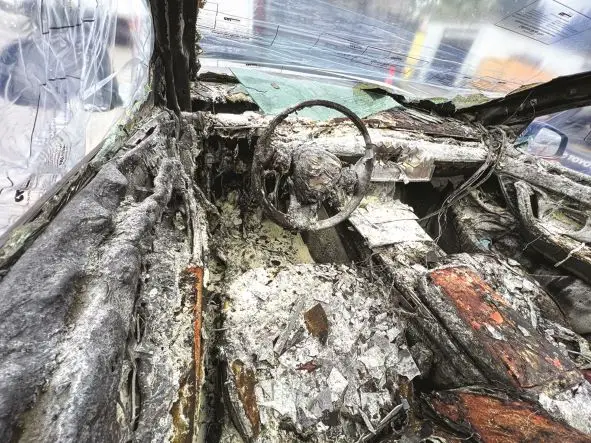
Storage
Another concern was storage. Although not common, a damaged EV can reignite, something which many people (including towers) are often not aware of. In a recent incident in Sacramento, a Tesla Model S that was in an accident and had been sitting in a wrecking yard for three weeks ignited itself, and the fire department had difficulty extinguishing the flames because the battery kept reigniting.11
EV fires can be notoriously difficult to put out: “Water, if used sparingly, can actually exacerbate a lithium battery fire by acting as a conductor. What’s needed is either copious amounts of water or even powdered graphite, something most firehouses would not readily have on hand. A 2020 NTSB study suggested that U.S. firefighters need different techniques for EV battery fires.”12
In the case of the Tesla Model S in Sacramento, the fire department had to resort to submerging it in water: “They dug a small pit, filled it with water, and then placed the Tesla inside. The water pit successfully extinguished the fire.”13
Ken Hendricks, senior industry advisor with the ARA and EVfriendly senior project manager, explains why extinguishing a lithium battery fire can be so challenging:
“These are different beasts because they don’t explode, even if they get into a really bad accident, but they can rupture. These batteries are composed of hundreds of individual cells, and the cells are similar to the batteries in your flashlight. They are all stacked to combine and increase the voltage, but what can happen is if even one of these cells becomes compromised, it can trigger a chain reaction, and that reaction can take 24 or 48 hours or more to erupt into flames. This is called a thermal runway. What many people don’t realize is that even if the fire has been put out, it can start up again overnight. It can actually do this for a period of up to 30 days.”
Given Mitchell’s Towing’s training and experience, they were aware of the above risks, so when the operator brought Jutha’s Tesla back to the company’s facility, the staff knew what to do.
“We created a space in an open area where the vehicle was under video surveillance, and we created a safe zone around it.” said Martin. “At a bare minimum, you need three vehicles stalls for storage.”
Martin said that ideally, a company would have a concrete barricade in their yard, but that would require at least seven spaces and not all companies, especially ones in metropolitan areas, have that much space available, nor are they compensated for it.
Investigation and removal
Transport Canada was also particularly interested in this incident, given the fire did not appear to have started in the battery, so Mitchell’s Towing held the vehicle for about a week so Transport Canada could investigate.
Following the investigation, it was determined that the vehicle would be moved to an ICBC facility, given it costs ICBC triple the daily rate for EV storage when the vehicle is heavily damaged because they requires so much space.
But according to Martin, ICBC had some reservations about moving the vehicle as well, given the EV’s high-voltage system was still connected: “So Transport Canada came down, and they asked us to use the forklift to open the front hood. Obviously, the hood’s electronic release was inoperable, so we were instructed to use the forks of the forklift. We pried the hood open, disconnected the 12-volt system, and then we wrapped the positive with red tape and the negative with black tape and stored the cables off to the side. Transport Canada wanted to ensure that the 12-volt system was disconnected, and that there was no more power or opportunity for power to allow the relays to open.”
According to Martin, you can also open the hood by supplying a 12-volt jump to the tow hook pin, but that was not an option: “Transport Canada did not want us to supply power back to the car, so we did it this way at their request, as they wanted to document this method for other Transport Canada branches, since they had never seen this before. They took dozens of pictures.”
Martin notes that Tesla does have a first responders loop. It’s in the front, and it’s clearly marked. “In the event of a severe motor vehicle accident where the operator is not able to mechanically disconnect the 12-volt system, you do have the opportunity to cut the 12-volt responders loop, and that will in turn shut off the 12-volt system as well,” said Martin.
Need to know
When asked what other towers can take away from this incident, Martin said, “In general towing from A to B is very similar to any other vehicle. There are different products that are recommended such as soft straps and soft bridles to bring an EV up on to a flat deck, but when it comes to vehicle storage, or potential hazards, I think that most towing companies are not up to speed yet on what the best practices should be, and this is where training comes in.
“An EV battery can very easily discharge if a car has been compromised in some way, so that’s where potential risks still come in to play. Now, if an EV has already caught fire from the battery and has had a massive blowout, then there is probably very little residual electricity or power left. However, with this Tesla, this wasn’t the case. The opportunity for something to continue was still there.”
Martin notes that ICBC has implemented a new battery disconnect policy for all EV and hybrid vehicles: “They will pay half an hour labour for a battery disconnect. If the vehicle is damaged and this takes more time, document your experience and bill accordingly.”
The second most vital thing of which an operator needs to be aware is proper EV storage. “You need to create space, said Martin. “It’s challenging because you have to make sure that there’s nothing else around the vehicle. A concrete barricade can be built to store electric vehicles, but we don’t have a lot of square footage available, meaning that it’s super expensive to tie it up. Our land this year was assessed at $20,444,000 per acre. In the Lower Mainland, the necessary square footage is a bit of a concern for cost.
“Once a vehicle goes up, if you are not prepared, or you do not take the measures that you should, it can be bad. These fires are difficult to extinguish. So you best be prepared if you have a damaged EV in your space. Be aware, and don’t park any of your tow trucks around it! And this advice goes for the people that are repairing them too. If you are storing them inside, or on the property, you need to know the risks. You could also use something like a fire blanket.”
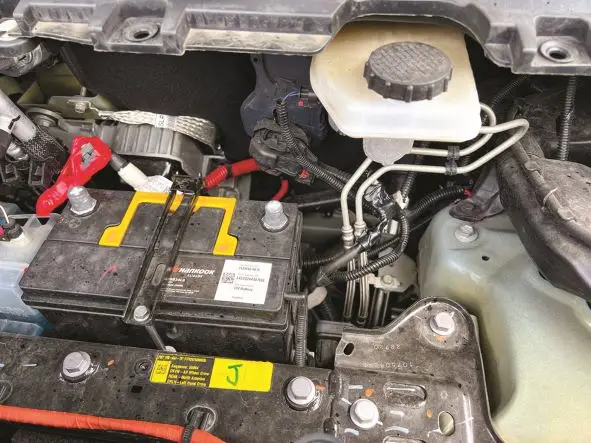
Training
If this story amplifies anything, it is the need for training. EV training will arm operators with the skills and knowledge they need to assess a scene, survey for hazards, load and recover an EV, and properly store and manage them.
Mitchell Martin credits the training he received through the ARA’s EVfriendly program and BCIT’s electric vehicle service technician course for providing his company with the necessary training to safely handle EVs. Mitchell’s Towing is also one of the original Tesla service providers and has worked with the company since its inception.
“The ARA has done a fantastic job of putting their program together,” said Martin. “It is available online, and you don’t have to be a B.C. tower to take the course.”
EVfriendly is an industry-led program, sponsored by the Ministry of Energy, Mines and Low Carbon Innovation and developed by the Automotive Retailers Association to help address issues of safety, training, and consumer confidence in the transition to ZEVs.14 The program is designed to help businesses transition into servicing electric vehicles.
For more information about this timely and accessible program, look for It’s Time to Become EVfriendly (Part 2) in the next edition of Tow Canada, or visit evfriendly.ca. B.C. has inevitably been a leader in this growing sector.
1 Lambert, F. (2022, May 23). “Tesla catches fire at an intersection.” Electrek. Retrieved June 13, 2022.
2 Note: Tesla’s do have a manual release lever, it just isn’t necessarily apparent to someone who may be panicking in an emergency situation, or who may be looking for it for the first time.
3 Lambert, F. (2022, May 23). “Tesla catches fire at an intersection.” Electrek. Retrieved June 13, 2022.
4 EVfriendly. (2022). “Towing: Keeping Your Operators Safe. Automotive Retailers Association.” Retrieved June 14, 2022.
5 Transport Canada. (2022, April 22). “Minister of Transport announces the expansion of the Incentives for Zero-Emission Vehicles Program.” Government of Canada. Retrieved June 13, 2022.
6 Clean Energy Canada. (2022, March 31). “Electric vehicles save Canadian drivers thousands over car’s lifetime, even at lower gas prices: analysis.” Simon Fraser University. Retrieved June 13, 2022.
7 Ibid.
8 Ministry of Energy, Mines and Low Carbon Innovation. (2022, June 1). “B.C. supports EV adoption from purchase through repair.” Government of British Columbia. Retrieved June 12, 2022.
9 Ibid.
10 CTV News. (2022, May 14). “Would-be EV buyers in B.C. stymied by supply issues, report finds.” CTV News. Vancouver. Retrieved June 14, 2022.
11 Merano, M. (2022, June 12). “Tesla catches fire in Sacramento wrecking yard three weeks after accident.” Teslarati. Retrieved June 17, 2022.
12 Olsen, E. (2021, April 21). “Electric vehicle fires are rare, but challenging to extinguish.” Popular Science. Retrieved June 15, 2022.
13 Ibid.
14 EV Friendly. (2022). “Towing: Keeping Your Operators Safe.” Automotive Retailers Association. Retrieved June 14, 2022.
